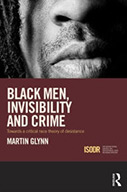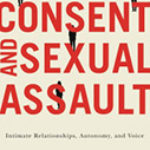Black Men, Invisibility and Crime towards a Critical Race Theory of Desistance

Author: Martin Glynn
Publisher: Routledge Press, London, 2014. 200p.
Reviewer: James D. Unnever | July 2015
Blacks are vastly over represented among the population of prisoners within the U.S. Perhaps less well known is the fact that blacks are even more disproportionately represented in prison populations in the UK than in the U.S. These statistics are the compelling reason why Martin Glynn argues there is a need for a “black criminology” that explores the racial dynamics associated with the desistance of black male offending both in the U.S. and in the UK.
Building on and consistent with the work of Unnever and Gabbidon’s (2011) Theory of African American Offending, Glynn contends that a theory of desistance that focuses on African American men and their “lived experiences” within racialized societies is needed. Similar to Unnever and Gabbidon (2011), Glynn argues that African American men have a unique racialized worldview that emerges from their interactions with oppressive white-dominated institutions. The cumulative result of these subordinating interactions is that black men have a compromised racial identity. This conflicted racial identity is formed in interactions with racialized institutions—particularly the criminal justice system—that devalue and pejoratively stereotype black men.
Glynn further argues that African American male offending is a “counter-culture” defiant response to black men feeling powerless and compelled to negate their blackness or to “act white.” Their likelihood of offending is further exacerbated if they were raised in a fatherless home and reside in resource-depleted inner cities where their sense of manhood emerges when they join racialized gangs. These racialized gangs are hyper-masculine and nihilistic. They perpetuate the “code of the streets,” which values honor and toughness and the willingness to forgo everything for the limited gains of criminal activity. In short, he concludes that crime for black men is a metaphor for defiance against their subordination in much the same way as slaves were defiant to being held captive on plantations.
From this perspective, Glynn qualitatively studied the life histories of 11 black men who reside in Birmingham, UK who were formerly incarcerated; 10 black male prisoners who were housed in Grendon, UK, a prison-based therapeutic community; and, for cross-cultural comparisons, nine black male former prisoners from the inner city of Baltimore, MD, U.S. The author identifies himself as an “insider researcher,” as he reports his own racial identity as being black. He employed a grounded theory and urban ethnography approach in order to acknowledge and validate the stories that African American men tell of their own understandings and insights into their desistance. His overarching theoretical framework is critical race theory. Thus, the methodological focus of Glynn’s work is to provide a platform for black men who have been imprisoned to “narrate” and “interpret” their “own reality by bringing coherence to their ‘real-life’ stories, creating a ‘counter-narrative’ that would challenge and contest what many academics claim about their criminality, with reference to their desistance trajectories” (Glynn 2014:2).
Glynn’s research reveals common themes among the black men that generalize across the research sites. Their stories detail their encounters with their racialized imprisonment. The men discuss feelings of alienation within prison as they perceived that they were judged through white racist lenses that labeled them pejoratively as “thugs.” In addition, their blackness was denied, as they had little to no access to different aspects of black culture including black literature and spirituality. Indeed, many of the black men report having to “mask” their language in order to avoid being negatively judged as threatening. In short, he argues that African American men who have been imprisoned have a heightened sense that the criminal justice system is racist, and that they were treated unfairly because they are black.
Glynn believes that this penetrating awareness that the criminal justice system is racialized acts as a significant barrier to their desistance. This profound sense of racial injustice is compounded upon their release when they reenter communities that collectively define black men as the “criminalblackman.” Desistance becomes even more problematic as they recognize that their community has few meaningful work-related opportunities because it is resource depleted. The men also are challenged by their gang affiliated friends to reoffend.
Collectively, these racialized social forces inhibit the ability of these inner city black men to form a pro-social identity that is empowering to them because they are black men. Instead, these racialized barriers explain why black men feel that there are few opportunities that allow them to feel good about being a black man. They are presented with the choice of accepting their racial subordination or defiantly opposing it through their persistence in crime. That is, how can black men desist from crime when society defines them as the “criminalblackman”?
Glynn further believes that black men’s desistance from crime must be understood in terms of how they overcome the racialized barriers that challenge their ability to be proud of their race and gender. He states that “a sense of racial pride and improvement of self-concept are necessary for black men to be motivated towards desistance” (2014: 129). He uses one case study of “Ibrahim”—one of the few successful desistors in his study—to illustrate this core hypothesis. Ibrahim’s successes are directly related to his spiritual transformation in prison as he became a Muslim. This transformation was critical because it allowed him to “knife off” relationships in and outside of prison with those who were still hustling. It was also crucial because it allowed Ibrahim to reintegrate into the black community in a pro-social way as he opened and operated a small business with other Muslims from his mosque. In the end, these successes allowed Ibrahim to be a proud black man within the black community.
Some comments for consideration: (1) Glynn defines himself as an “insider researcher” and recognizes the biases that can emerge when taking on that role. Therefore, it would have been insightful had there been a self-reflexive discussion of how he constructed the semi-structured interviews. It is possible that the assumptions that are inherent to the semi-structured interview could be possible sources of bias. (2) The author uses the term “racialized” in a multitude of ways that he relates to either offending or failure to desist. He needs to articulate with some precision exactly what are “racialized institutions,” and specifically how they are a cause of the failure to desist. (3) His data mostly include black men who were gang affiliated. Consequently, a common theme of his book is the impact that the code of the street has on black desistance. Is this emphasis on the code of the street warranted for non-gang members? (4) Glynn hints at but does not offer a full blown theoretical explanation of whether there is something unique about being black and being raised in a fatherless household. He argues that this is a key reason why inner city black men join gangs. But other scholars argue that being raised in a fatherless household is a salient reason for why young men, regardless of their race/ethnicity, join gangs. What is needed is a racialized explanation of why being raised in a fatherless household uniquely explains black male offending or desistance. (5) Similarly, scholars recognize that a code of streets can be found in inner city neighborhoods predominately occupied by minorities other than blacks (e.g., Latinos). Consequently, a racialized explanation of the emergence of the code of the streets and why it is particularly problematic for inner city black men is warranted. (6) This book would have been more theoretically powerful had the author used his data to present a racialized critique of how life-course theory—a prevailing general theory of crime—explains desistance. For example, life course theory singles out marriage as a key cause of desistance, yet Glynn does not even mention it as a relevant cause of desistance among black men. Is that because marriage is not a relevant cause of black male desistance?
All that said, this book is a must read for three groups. First, individuals who are ideologically resistant to the emerging black criminology will particularly profit from reading the book. They will find that Glynn’s analysis challenges their basic assumption that generic general theories of crime can fully account for the reasons why blacks commit or desist from crime. Second, this is a must read for criminologists who study prisons and prison reentry. The author provides ample evidence that indicates that the needs of black men to successfully desist from crime are uniquely different from whites and other minorities. Third, individuals who endorse the assumption that a black criminology that incorporates the lived experiences of blacks residing in racist societies is needed, will likewise benefit from reading this book. Martin Glynn’s work, coupled with Unnever and Gabbidon’s (2011) theory of African American offending, provides a solid foundation and springboard for understanding the onset and desistance of crime among blacks living in racist societies.
Unnever, James D. and Shaun Gabbidon. 2011. A Theory of African American Offending: Race, Racism, and Crime. Routledge, New York.
James D. Unnever,
Professor of Criminology,
University of South Florida-Sarasota Manatee


